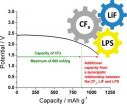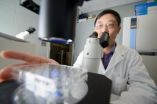(Press-News.org) TORONTO – Baker's yeast is giving scientists a better understanding of drug interactions, which are a major cause of hospitalization and illness world-wide.
When two or more medications are taken at the same time, one can suppress or enhance the effectiveness of the other. Similarly, one drug may magnify the toxicity of another. These types of interactions are a major cause of illness and hospitalization. However, there are severe practical limits on the practical scope of drug studies in humans. Limits come in part from ethics and in part from the staggering expense. Because of the vast number of combinations of different drugs that might be prescribed together in the same patient, drug interactions in patients are not extensively studied, even in the process of reviewing new drugs for approval.
This limitation has caused researchers to turn to simpler model organisms in which to study drug interactions, enabling systematic study of drug interactions at relatively low cost, according toresearchers at the Lunenfeld-Tanenbaum Research Institute at Mount Sinai Hospital in Toronto. Dr. Frederick Roth and international colleagues published their findings after testing drugs on the simple yeast Saccharomyces cerevisiae, also known as brewer's yeast or baker's yeast.
Surprising effect
"Baker's yeast is a wonderful tool for this purpose," says Dr. Roth. "Many aspects of both yeast and human genomes have remained the same since they diverged from a common ancestor around one billion years ago. When a specific combination of drugs has a surprising effect on yeast growth there is no guarantee that it will do the same thing tohuman cells. But it does give us a general idea of how often drugs are able to enhance or suppress each other's effectiveness." Dr. Roth is a Senior Investigator at the Lunenfeld-Tanenbaum and a Professor at the University of Toronto's Donnelly Centre. He also holds a Canada Excellence Research Chair in Integrative Biology.
For this first test, the team worked with anti-fungal chemicals in a total of 440 drug pairs. They found that, in almost one fifth of the combinations, one drug reduced the effectiveness of the other drug. They also found that some drugs can have a greater tendency to suppress other drugs, while other drugs are more frequently suppressed. The same team published a related study in 2011, showing that for about one third of drug pairs tested the compounds increased each other's effectiveness. "If drug interactions are happening at anything approaching these rates in humans, we should be very concerned," Dr. Roth adds.
When one drug suppresses the effectiveness of another drug, "the patient is losing benefit from one or both drugs, while still potentially being exposed to their side effects," Dr. Roth adds. When a drug combination has an effect that is more than the sum of its parts, the patient might get too much of a good thing, and it is possible for drugs to intensify each other's toxicity as well.
"This methodology may also prove useful to explore positive types of drug interactions such as in personalized medicine," adds Dr. Jim Woodgett, Director of the Lunenfeld-Tanenbaum. "Diseases such as cancer rarely respond to single medications, and this new systematic technological approach may have the potential to allow rapid optimization of combination therapies," he notes. The study noted one example of a compound (Staurosporine) that was suppressed by acidity. This phenomenon is interesting in the context of cancer because the peculiar metabolism of cancer cells often makes the local tumour environment more acidic. It would be particularly exciting to find more anti-cancer compounds that were enhanced by acidity.
INFORMATION:
The paper "Large-scale identification and analysis of suppressive drug interactions" is published in Chemistry & Biology (Cell Press), April 24, 2014. An editorial published in the same issue supports continued development of this research approach. Coauthors include researchers from Cold Spring Harbor Laboratory, Dana-Farber Cancer Institute, UC San Francisco, Sabanci University (Istanbul), University of Toronto, and Boehringer Ingleheim Pharmaceuticals.
Drug Interactions - Backgrounder
Adverse drug reactions (including interactions) have significant impact on visits to ED, hospitalization, health outcomes, and cost*
Most of our knowledge of drug interactions relies on reporting by individual patients and physicians
Drug classes that can interact negatively with other medications include: antibiotics, blood thinners, diuretics, hypoglycemics, chemotherapy, NSAIDs
Individuals at risk of drug interactions include those who:
Take a medication long-term (e.g., for birth control, hypertension), who may then take other medications
Are elderly, infants, or children
Have a complex medical condition for which several drugs (including over-the-counter) are used, either at home or in hospital
*e.g., Pirmohamed M. et al., Adverse drug reactions as a cause of admission to hospital: prospective analysis of 18,820 patients, BMJ 2004;329:15 .
For information or interview with Dr. Roth:
Polly Thompson
Lunenfeld-Tanenbaum Research Institute
Mount Sinai Hospital
Toronto, Canada
(416) 586-4800 #2046
pthompson@lunenfeld.ca
Large-scale identification and analysis of suppressive drug interactions
2014-04-24
ELSE PRESS RELEASES FROM THIS DATE:
Skin layer grown from human stem cells could replace animals in drug and cosmetics testing
2014-04-24
An international team led by King's College London and the San Francisco Veteran Affairs Medical Center (SFVAMC) has developed the first lab-grown epidermis – the outermost skin layer - with a functional permeability barrier akin to real skin. The new epidermis, grown from human pluripotent stem cells, offers a cost-effective alternative lab model for testing drugs and cosmetics, and could also help to develop new therapies for rare and common skin disorders.
The epidermis, the outermost layer of human skin, forms a protective interface between the body and its external ...
Scripps Research Institute scientists find new point of attack on HIV for vaccine development
2014-04-24
LA JOLLA, CA— April 24, 2014 —A team led by scientists at The Scripps Research Institute (TSRI) working with the International AIDS Vaccine Initiative (IAVI) has discovered a new vulnerable site on the HIV virus. The newly identified site can be attacked by human antibodies in a way that neutralizes the infectivity of a wide variety of HIV strains.
"HIV has very few known sites of vulnerability, but in this work we've described a new one, and we expect it will be useful in developing a vaccine," said Dennis R. Burton, professor in TSRI's Department of Immunology and Microbial ...
Three-banded panther worm debuts as a new model in the study of regeneration
2014-04-24
CAMBRIDGE, Mass. (April 24, 2014) – Closely resembling plump grains of wild rice set in motion, the three-banded panther worms swimming in disposable containers in Whitehead Institute Member Peter Reddien's lab hardly seem like the next big thing in regeneration. And yet, these little-studied organisms possess the ability to regenerate any part of their bodies and are amenable to molecular studies in the lab, making them a valuable addition to a field keen on understanding how mechanisms controlling regeneration have evolved over millennia and how they might be activated ...
Engineered E. coli produces high levels of D-ribose as described in Industrial Biotechnology journal
2014-04-24
New Rochelle, NY, April 24, 2014—D-ribose is a commercially important sugar used as a sweetener, a nutritional supplement, and as a starting compound for synthesizing riboflavin and several antiviral drugs. Genetic engineering of Escherichia coli to increase the bacteria's ability to produce D-ribose is a critical step toward achieving more efficient industrial-scale production of this valuable chemical, as described in an article in Industrial Biotechnology, a peer-reviewed journal from Mary Ann Liebert, Inc., publishers. The article is available on the Industrial Biotechnology ...
Oxygen diminishes the heart's ability to regenerate, researchers discover
2014-04-24
DALLAS – April 24, 2014 – Scientific research at UT Southwestern Medical Center previously discovered that the newborn animal heart can heal itself completely, whereas the adult heart lacks this ability. New research by the same team today has revealed why the heart loses its incredible regenerative capability in adulthood, and the answer is quite simple – oxygen.
Yes, oxygen. It is well-known that a major function of the heart is to circulate oxygen-rich blood throughout the body. But at the same time, oxygen is a highly reactive, nonmetallic element and oxidizing agent ...
New study helps to explain why breast cancer often spreads to the lung
2014-04-24
New research led by Alison Allan, PhD, a scientist at Western University and the Lawson Health Research Institute, shows why breast cancer often spreads or metastasizes to the lung.
Breast cancer is the number one diagnosed cancer and the number two cause of cancer-related deaths among women in North America. If detected early, traditional chemotherapy and radiation have a high success rate, but once the disease spreads beyond the breast, many conventional treatments fail. In particular, the lung is one of the most common and deadly sites of breast cancer metastasis ...
Parents of severely ill children see benefits as caregivers, says study
2014-04-24
Benefits often coexist with the negative and stressful outcomes for parents who have a child born with or later diagnosed with a life-limiting illness, says a recent study led by a researcher at the University of Waterloo.
While the challenges are numerous and life-changing and stress levels high, the vast majority of parents who participated in the Waterloo-led research reported positive outcomes as well, a phenomenon known as posttraumatic growth. The findings appear in the most recent issue of the American Journal of Orthopsychiatry.
"What is pivotal is the meaning ...
'Double-duty' electrolyte enables new chemistry for longer-lived batteries
2014-04-24
OAK RIDGE, Tenn., April 24, 2014 — Researchers at the Department of Energy's Oak Ridge National Laboratory have developed a new and unconventional battery chemistry aimed at producing batteries that last longer than previously thought possible.
In a study published in the Journal of the American Chemical Society, ORNL researchers challenged a long-held assumption that a battery's three main components -- the positive cathode, negative anode and ion-conducting electrolyte -- can play only one role in the device.
The electrolyte in the team's new battery design has ...
Cell resiliency surprises scientists
2014-04-24
EAST LANSING, Mich. --- New research shows that cells are more resilient in taking care of their DNA than scientists originally thought. Even when missing critical components, cells can adapt and make copies of their DNA in an alternative way.
In a study published in this week's Cell Reports, a team of researchers at Michigan State University showed that cells can grow normally without a crucial component needed to duplicate their DNA.
"Our genetic information is stored in DNA, which has to be continuously monitored for damage and copied for growth," said Kefei Yu, ...
Vanderbilt study finds physical signs of depression common among ICU survivors
2014-04-24
Depression affects more than one out of three survivors of critical illness, according to a Vanderbilt study released in The Lancet Respiratory Medicine, and the majority of patients experience their symptoms physically rather than mentally.
It is one of the largest studies to investigate the mental health and functional outcomes of critical care survivors, according to lead author James Jackson, Psy.D., assistant professor of Medicine, and it highlights a significant public health issue, with roughly 5 million patients admitted to intensive care units (ICUs) in the United ...






